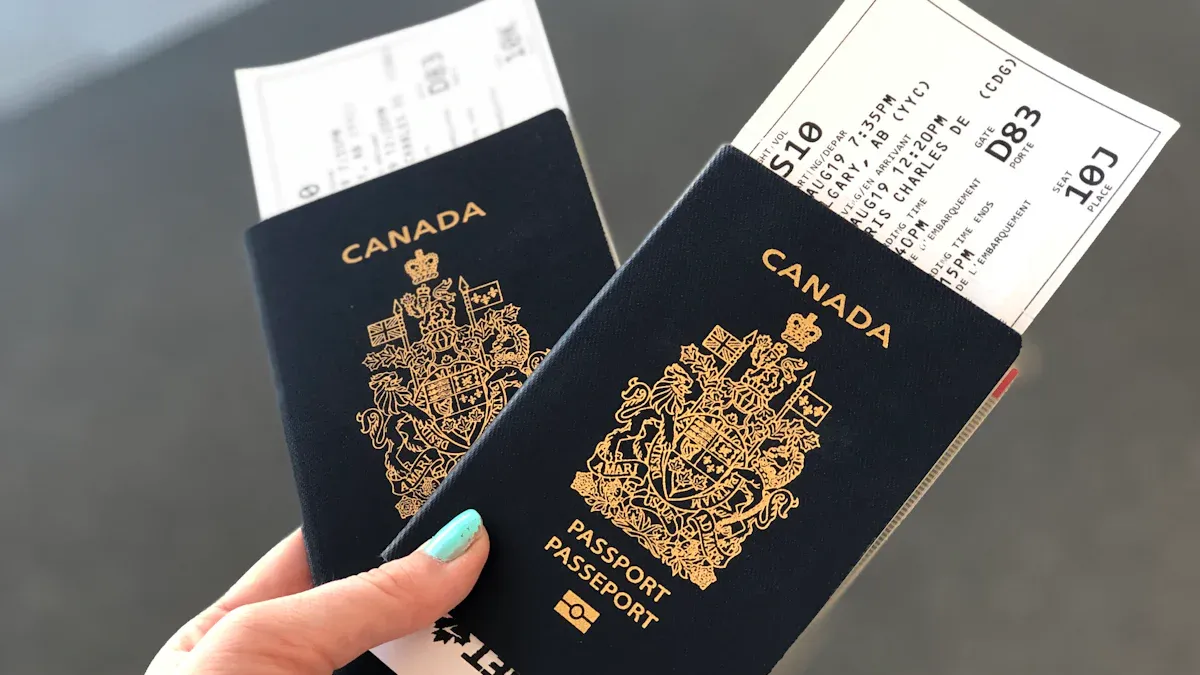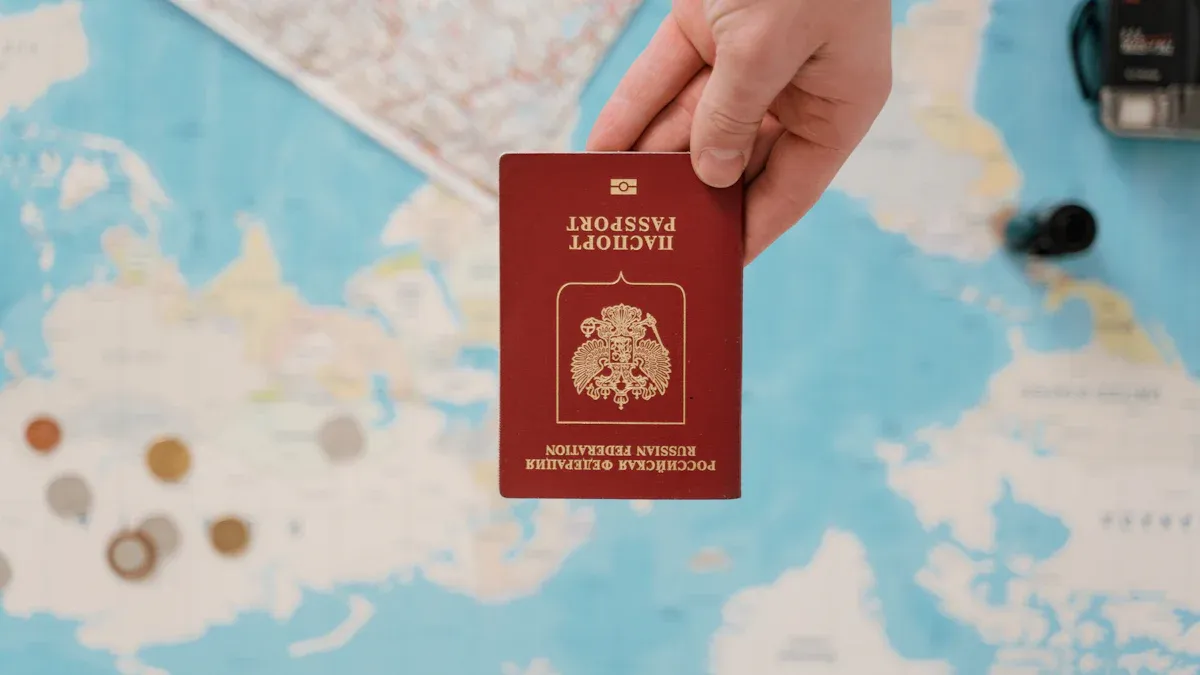- EasyCard
- Trade
- Help
- Announcement
- Academy
- SWIFT Code
- Iban Number
- Referral
- Customer Service
- Blog
- Creator
Passport requirement stories from real US travelers to Canada

Image Source: unsplash
You might ask, “Do I need a passport to visit Canada from the United States?” The answer is yes. The passport requirement applies to almost every US traveler crossing into Canada. You may feel unsure about what happens if you do not have the right document. Many people have faced this situation. Real stories from travelers can help you understand what to expect at the border.
Key Takeaways
- All US travelers need a valid passport or approved ID to enter Canada, whether by air, land, or sea.
- For air travel, only a passport book or NEXUS card is accepted; passport cards and other IDs work for land and sea travel.
- Prepare your documents before your trip and keep them organized to avoid delays or denial at the border.
- Using trusted traveler cards like NEXUS can speed up border crossing and reduce wait times.
- If you forget your passport, contact the US embassy for help and carry extra documents for children or special cases.
Passport Requirement for US Travelers

Image Source: pexels
Air Travel
When you fly from the United States to Canada, you must follow strict rules. The passport requirement is clear for air travel. You need to show one of these valid travel documents at the airport:
- Passport
- NEXUS card
- Permanent Resident Card issued by the US
- Enhanced driver’s license from the US
You must present a valid, unexpired document. Airlines will not let you board if you refuse to show your ID, do not look like your photo, or will not show your face. Your name on your ticket must match your travel document. You may also need to give your date of birth and gender when you book your flight.
Tip: Air Canada recommends that you always carry your passport, even if you have another approved document.
Canadian border officials check your documents carefully. They enforce the passport requirement for US travelers by air. If you do not have the right document, you cannot enter Canada.
Land Travel
If you drive or walk across the border, you still need to meet the passport requirement. You have several options for documents if you are 16 or older:
- United States Passport
- United States Passport Card
- Trusted Traveler Card (NEXUS, FAST, SENTRI)
- Enhanced Driver’s License (Washington, Minnesota, Michigan, New York, Vermont)
- Enhanced Learner’s Permit or Enhanced State ID card (must be permanent)
- Merchant Mariner Document
- Military ID with military orders
- Form I-872, American Indian Card
For travelers under 16, a birth certificate or other proof of citizenship is enough. If you are traveling with children, you may need extra paperwork, like a letter from a parent or guardian.
Note: Border officials check your documents every time. They do not make exceptions for adults. The passport requirement is strict, but minors have some flexibility.
Sea Travel
Traveling to Canada by boat or cruise ship also means you must follow the passport requirement. You can use:
- Valid Passport
- U.S. Passport Card
- Trusted Traveler card (NEXUS)
- Enhanced Driver’s License (from certain states)
- Enhanced identification cards (such as enhanced Tribal cards)
- U.S. Permanent Resident Card (Green Card)
- U.S. Military ID with travel orders
- U.S. Merchant Mariner Document for official business
If you are 15 or younger, you can use a birth certificate or citizenship card. Some travelers may need a visa, depending on their nationality.
Tip: Always check your documents before your trip. Make sure they are valid and match your travel plans.
The passport requirement helps keep the border process clear and safe. You must have the right documents, no matter how you travel.
Entry Documents Accepted
Passport Card
You can use a U.S. passport card for travel to Canada by land or sea. The passport card is wallet-sized and fits easily in your pocket. It is less expensive than the passport book and works well for frequent travelers who cross the border by car or ferry. The card contains RFID technology, which helps speed up processing at border crossings.
Note: You cannot use a passport card for air travel to Canada. Airlines require a passport book for all international flights.
Here is a quick comparison between the passport book and the passport card:
| Feature | U.S. Passport Book | U.S. Passport Card |
|---|---|---|
| Valid for travel by | Air, land, and sea | Land and sea only |
| Valid for travel to Canada | Yes | Yes, but only by land or sea, not air |
| Valid for air travel | Yes | No |
| Physical form | Navy blue booklet with visa pages | Wallet-sized plastic card without visa pages |
| Cost | More expensive | Less expensive |
| Use case | All international travel modes | Land/sea travel to Canada, Mexico, Bermuda, Caribbean |
You should choose the passport card if you travel to Canada by car or boat and want a simple, affordable option.
NEXUS Card
The NEXUS card helps you cross the border faster. You can apply for this card if you are a U.S. or Canadian citizen or a permanent resident. The NEXUS program gives you access to special lanes at land border crossings and marine ports. You must make sure everyone in your vehicle has a NEXUS card to use these lanes.
The NEXUS card serves as proof of both identity and citizenship. You do not need to show a passport or birth certificate when you use it at land or sea entry points. The card also meets the Western Hemisphere Travel Initiative requirements and allows you to re-enter the U.S. from Canada.
Tip: The NEXUS card can save you time and reduce wait times at busy border crossings.
Other Proof of Citizenship
You have other options if you do not have a passport or NEXUS card. For land or sea travel, border officials accept several documents as proof of citizenship:
- Birth certificate (with photo ID)
- Certificate of citizenship or naturalization
- Certificate of Indian status (with photo ID)
- Enhanced driver’s license or enhanced state ID card
- Trusted traveler cards like FAST or SENTRI
If you are a U.S. permanent resident, you can use your permanent resident card. Children under 16 can use a birth certificate. These alternatives work for land and sea crossings, but not for air travel. Always check that your documents are valid and accepted before your trip.
Traveler Stories
With Passport
Many US travelers find that having a valid passport makes the border crossing process smoother. You may notice that border officers often ask to see your passport, especially if you have dual citizenship or if your documents show a US place of birth. Here are some common experiences:
- You must show your passport when asked, even if you are not always required to present it at every checkpoint.
- If you travel with both US and Canadian passports, you should present the passport for the country you are entering. This helps avoid confusion.
- Officers sometimes ask questions about your citizenship. If you answer clearly and cooperate, you usually pass through quickly.
- Expired passports can cause delays. Always check your passport’s expiration date before your trip.
Travelers say that being prepared and having your documents ready helps you meet the passport requirement and avoid problems.
Without Passport
Some travelers cross the border without a passport, but only if they have other accepted documents. You can use a passport card, enhanced driver’s license, or a Trusted Traveler Program card. These options work for land and sea travel. For air travel, you still need a passport book.
- If you are over 16, you may use a passport card or enhanced driver’s license.
- Children under 16 can use a birth certificate for land or sea travel.
- Airlines and border officers may still ask for a passport, so you should always check the latest rules.
Travelers who try to cross without any approved document often face delays or are denied entry. The passport requirement is strict, and exceptions are rare.
Using Alternatives
You may choose to use a NEXUS card or other Trusted Traveler Program cards. Here is what you can expect:
- Present your membership card at the dedicated lane.
- The officer scans your card and checks your identity.
- You answer questions about your trip, such as your purpose and how long you plan to stay.
- If everything matches, you move forward. If not, you may go to a secondary inspection.
Border officers check your documents and ask about your plans. If you answer honestly and have the right documents, you usually cross without trouble. Travelers say that using alternatives can save time, but you must still meet all entry requirements.
Border Experiences

Image Source: pexels
Delays and Denials
You may face delays or even denial at the Canadian border if you do not have the right documents. Border officers check your passport or approved ID every time. If you forget your passport, you might wait while officers verify your identity. Sometimes, travelers bring items that are not allowed, such as certain foods or large amounts of cash. Officers may ask you to explain these items or send you to a secondary inspection area. If you cannot provide the correct paperwork for children or pets, you may not be allowed to enter. You can avoid most delays by preparing your documents and understanding what you can bring.
Note: Always declare all goods, gifts, and currency over $10,000 USD. Failing to do so can cause long delays or denial of entry.
Smooth Crossings
You can make your border crossing much easier by following a few simple steps. Many travelers report that these practices help:
- Prepare all travel documents, such as your passport, vehicle registration, and customs forms.
- Avoid peak travel times like weekend evenings or holiday Mondays.
- Choose less busy border crossings and plan your route ahead of time.
- Use the Advance Declaration tool if you fly, which can cut your processing time in half.
- Make full and accurate customs declarations, including receipts for purchases.
- Follow all instructions from border officers and answer questions clearly.
If you travel with children, bring signed consent letters if one parent is not present. Keep your vehicle in good condition and carry an emergency kit. These steps help you move through the border quickly and with less stress.
Common Questions
You may have questions before you reach the border. Here are some of the most common:
- What documents do you need to enter Canada?
- How do you fill out customs forms and what must you declare?
- What happens at the primary inspection checkpoint?
- What if you connect to another flight or continue traveling in Canada?
- What should you do if you are a student, worker, or newcomer?
- How do you handle baggage claim, pay duties, or go through secondary inspection?
- What are the rules for arriving by land or private boat?
- Are there trusted traveler programs to speed up the process?
- What are the ID requirements for children?
Knowing the answers to these questions helps you prepare and makes your trip smoother.
Tips for US Travelers
Preparing Documents
You can make your trip to Canada much easier by preparing your documents ahead of time. Many experienced travelers recommend these steps:
- Check which identification documents you need. Most travelers must meet the passport requirement, so make sure your passport is valid.
- Apply for any visas or Electronic Travel Authorizations (ETAs) if needed. Complete these steps early to avoid last-minute problems.
- Prepare a consent letter for children traveling without both parents. This helps you avoid delays at the border.
- If you plan to drive, consider getting an International Driving Permit.
- Buy travel insurance and carry proof with you. This protects you in case of emergencies.
- If you have dual citizenship, learn which documents you need for your status.
- Make copies of all your travel documents. Keep some copies with you and leave others with someone you trust.
You should organize your documents in a way that makes them easy to find. Use a folder or plastic sleeve for paper copies. Save digital copies on your phone and back them up to cloud storage. Keep your passport and other important items in a secure holder or wallet.
If You Forget Your Passport
If you realize you forgot your passport before reaching the border, stay calm. First, check all your bags, pockets, and hotel safes. If you still cannot find it, contact the nearest US embassy or consulate. They can help you get an emergency passport or travel document. You may need to show other identification and fill out a report. Emergency passports are often available the same day, but you might need to change your travel plans. If you are at a land border, you can ask if other documents like a birth certificate or driver’s license will work, but this depends on the border officer.
Avoiding Issues
You can avoid most problems by staying organized and alert. Carry only the documents you need and never leave them unattended. Scan and email copies of your passport and important papers to yourself. Store sensitive items in a zipped holder close to your body. Use a secure folder for receipts and maps. Protect your digital files with passwords and keep them on more than one device. Always follow the passport requirement and check your documents before you travel.
You need to meet the passport requirement when you travel from the US to Canada. Always check your documents before your trip. Bring the right ID, such as a passport, passport card, or trusted traveler card. Many travelers say that being prepared helps you cross the border faster. If you have questions, ask border officers for help. Careful planning makes your journey smoother.
FAQ
Do you need a passport to drive from the US to Canada?
Yes, you need a valid passport or an approved alternative, such as a passport card or enhanced driver’s license. Border officers will check your documents every time you cross by car.
Can you use a birth certificate to enter Canada?
You can use a birth certificate if you are under 16 and traveling by land or sea. Adults must show a passport or another approved document. Airlines do not accept birth certificates for international flights.
What happens if you forget your passport at the border?
Border officers may deny you entry if you do not have the right documents. You can ask if other IDs work, but you may need to return home or contact the US embassy for help.
Is a NEXUS card enough for air travel to Canada?
A NEXUS card works for air travel only if you use a NEXUS kiosk at certain airports. For most flights, you still need a valid passport. Always check your airport’s rules before you travel.
How long does your passport need to be valid for travel to Canada?
Canada requires your passport to be valid for the entire stay. You do not need six months of validity, but you should check your passport’s expiration date before your trip.
Tip: Renew your passport early if it will expire soon. This helps you avoid problems at the border.
Crossing the border smoothly means having the right documents in hand — and managing your money across borders should be just as simple.
With BiyaPay, you can send and receive money between the US, Canada, and beyond with real-time exchange rates, fees as low as 0.5%, and same-day transfers. Whether you’re covering tuition, rent, or travel costs, BiyaPay keeps your finances hassle-free so you can focus on your journey.
Travel with confidence — for your documents and your money. Start today with BiyaPay.
*This article is provided for general information purposes and does not constitute legal, tax or other professional advice from BiyaPay or its subsidiaries and its affiliates, and it is not intended as a substitute for obtaining advice from a financial advisor or any other professional.
We make no representations, warranties or warranties, express or implied, as to the accuracy, completeness or timeliness of the contents of this publication.




Contact Us
Company and Team
BiyaPay Products
Customer Services
is a broker-dealer registered with the U.S. Securities and Exchange Commission (SEC) (No.: 802-127417), member of the Financial Industry Regulatory Authority (FINRA) (CRD: 325027), member of the Securities Investor Protection Corporation (SIPC), and regulated by FINRA and SEC.
registered with the US Financial Crimes Enforcement Network (FinCEN), as a Money Services Business (MSB), registration number: 31000218637349, and regulated by FinCEN.
registered as Financial Service Provider (FSP number: FSP1007221) in New Zealand, and is a member of the Financial Dispute Resolution Scheme, a New Zealand independent dispute resolution service provider.



















